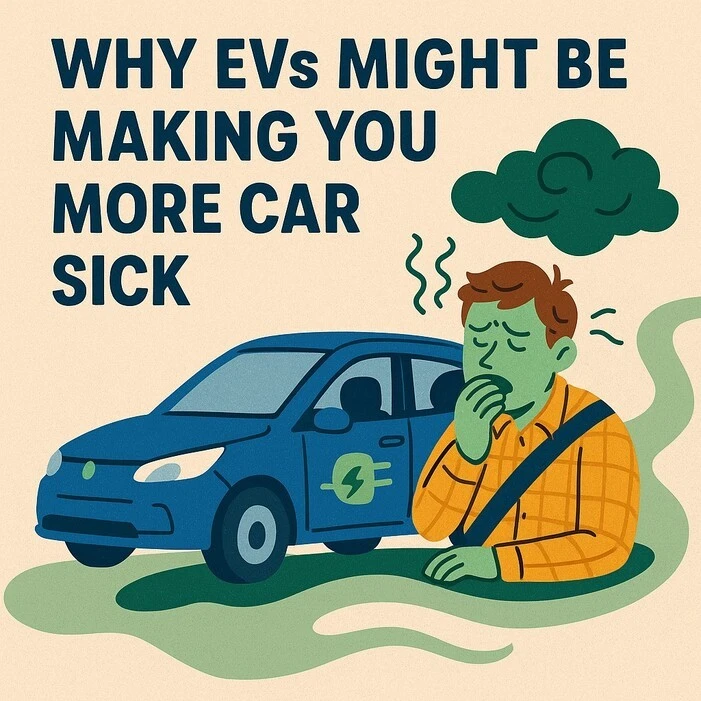Why EVs Might Be Making You More Car Sick

Electric vehicles (EVs) are often praised for their silent, smooth ride, but for many passengers, this futuristic calm is turning into a queasy experience. If you’ve stepped into an EV in Mauritius and found yourself feeling unexpectedly uncomfortable, you’re not alone, and now, science is starting to explain why.
The Missing Cues Your Brain Relies On
Traditional petrol and diesel cars come with a lot of noise and vibration. You feel the engine rev when accelerating, hear the subtle whirring as you change gears, and sense the gentle resistance of friction braking. These are more than just background noise, they're cues your brain uses to predict the car's movement.
In an EV, these mechanical signals are largely gone. According to William Emond, a PhD researcher at France’s Université de Technologie de Belfort-Montbéliard, passengers are “used to understanding the car’s motion based on signals such as engine revs, engine vibrations, torque.” Without them, the brain struggles to estimate how the vehicle is moving, which leads to a sensory mismatch, and that’s where nausea starts to creep in.
Drivers Rarely Get Sick. Passengers Do.
Here’s an interesting twist: drivers almost never get carsick. That’s because they’re in control, and they know exactly when and how the car will move. Passengers, on the other hand, rely on external cues to mentally brace for turns, stops, and accelerations. In a petrol car, that usually works fine.
But EVs, especially with their “one-pedal driving” and regenerative braking, behave differently. They often switch from rapid acceleration to sharp deceleration without the gentle coasting phase petrol drivers are familiar with. To your brain, it can feel like the car is lurching unpredictably, even if it’s technically driving smoothly. In Mauritius, where short commutes and windy coastal roads are common, the effects can be amplified. A leisurely weekend drive from Tamarin to Grand Gaube can quickly turn uncomfortable for passengers not used to the sharper, less predictable braking and acceleration of EVs. Add in the island’s stop-and-go traffic, speed bumps, and tight corners, and you’ve got the perfect recipe for a queasy backseat ride. It’s especially noticeable in newer electric models that embrace aggressive regenerative braking, something often praised for energy efficiency but not for passenger comfort. Two key studies back this up. A 2020 study highlighted how EV silence contributes to motion sickness, while 2024 research showed that the absence of vibrations, previously considered rough or “unrefined”, is actually a comfort loss for many passengers. So, in trying to create a quieter, smoother ride, EV makers may have accidentally removed the very sensations that kept passengers feeling stable. For now, if you’re a passenger prone to motion sickness in an EV, there are a few small tweaks that may help: - Sit in the front seat, where motion is more predictable - Focus your eyes on the road ahead rather than your phone or scenery - Keep the windows slightly open for ventilation - Ask the driver to ease off aggressive one-pedal driving styles if possible EV adoption in Mauritius is on the rise, and platforms like AutoCloud are seeing a growing number of electric listings from dealers and individuals alike. As this shift continues, it’s worth keeping passenger comfort in mind—not just tech specs. The future may be electric, but comfort is still human. As EVs evolve to be quieter and smoother, designers and drivers alike may need to reintroduce cues, auditory or otherwise, that help passengers stay in sync with the ride. For the smoothest experience in finding your next car, head to AutoCloud.mu.A Mauritius-Specific Twist
The Irony: Progress Feels Worse
So, What Can Be Done?
Final Thought
More Articles
![Will Penalty Points Make Mauritius’ Roads Safer This Time?]()
Will Penalty Points Make Mauritius’ Roads Safer This Time?
Mauritius is getting serious about road safety. With road deaths climbing and dangerous driving becoming all too common, the government ...Read more![Increased Police Presence for Mauritius Over the Festive Season]()
Increased Police Presence for Mauritius Over the Festive Season
A clear message for safer roads in MauritiusMauritius is heading into the festive season under tighter road surveillance, and the ...Read more![Road Works on the Black River–Savanne Coastal Road: What Commuters Need to Know]()
Road Works on the Black River–Savanne Coastal Road: What ...
If you travel along the scenic stretch between Rivière Noire village and Bel Ombre, expect some light disruptions over the ...Read more



